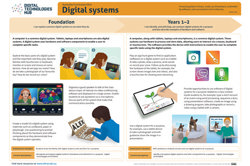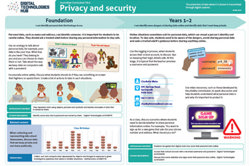Years 7–8: Hardware, networks and cyber threats
This scope and sequence unit explores how the performance of computer hardware – such as CPU and RAM – is determined by its specifications, and how digital networks (wired and wireless) can also be compared in terms of requirements. Students are introduced to the concepts of network protocols and cryptography for ensuring data integrity and security, and learn to identify and mitigate cyber security threats like phishing.
Additional details
| Year band(s) | 7-8 |
|---|---|
| Content type | Scope and sequence, Whole School |
| Format | Web page |
| Core and overarching concepts | Digital systems, Privacy and security |
| Australian Curriculum Digital Technologies code(s) |
AC9TDI8K01
Explain how hardware specifications affect performance and select appropriate hardware for particular tasks and workloads
AC9TDI8K02
Investigate how data is transmitted and secured in wired and wireless networks including the internet
AC9TDI8P13
Explain how multi-factor authentication protects an account when the password is compromised and identify phishing and other cyber security threats |
| Keywords | scope and sequence, scope, sequence |
| Integrated, cross-curriculum, special needs | Digital Literacy, Critical and creative thinking |
| Organisation | ESA |
| Copyright | Creative Commons Attribution 4.0, unless otherwise indicated. |
Related resources
-

GenAI readiness and implementation modules
As generative AI (GenAI) becomes an increasingly important tool in education, it's essential for teachers to understand both its potential and its limitations. This two-module offering equips teachers with the knowledge and practical skills to use GenAI tools like Copilot effectively in the classroom. Teachers will enhance their own digital literacy while learning how to guide students in using AI responsibly and thoughtfully. By focusing on teacher readiness and practical classroom strategies, the modules support the development of students who can navigate AI in both classroom and everyday contexts. The modules were developed in collaboration with Microsoft.
-

AI readiness: Preparing teachers for safe and effective use of GenAI
The module aims to increase teacher readiness when using generative AI (GenAI). It builds teachers' own digital literacy around GenAI and equips them to develop their students’ digital literacy capabilities. It is aimed at Australian F–12 teachers interested in learning about and exploring the use of generative AI for streamlining admin tasks and personalising learning, safely and responsibly. The module was developed in collaboration with Microsoft.
-

Years 7–8: Working with data
This scope and sequence unit focuses on the skills required to acquire, analyse and visualise data.
-

Digital systems: F-10 infographic
Digital systems is a core concept that is introduced in Foundation and continues through to Year band 9-10. View the poster for your Year band for an explanation of the concept with relevant examples and ‘I can’ statements. Use the posters to support planning and assist in implementing the Australian Curriculum Digital Technologies V9.0.
-

Privacy and security: F-10 infographic
Privacy and security is a core concept that is introduced in Foundation and continues through to Year band 9-10. View the poster for your Year band for an explanation of the concept with relevant examples and ‘I can’ statements. Use the posters to support planning and assist in implementing the Australian Curriculum Digital Technologies V9.0.
